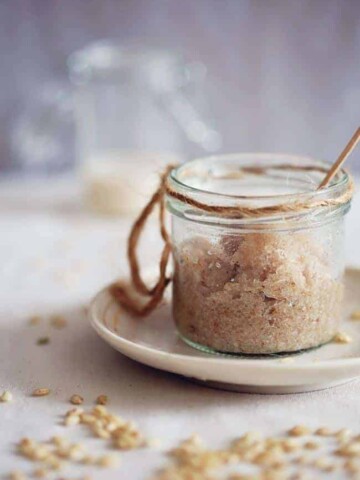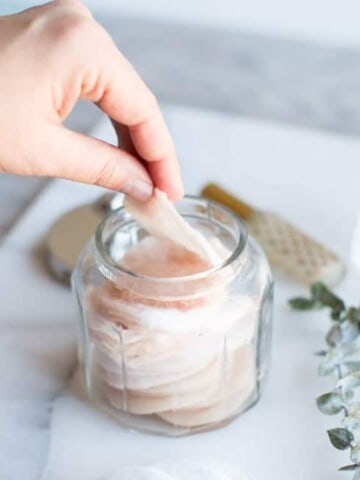These essential oil facial steamers are essentially bath bombs for your face. They contain baking soda and citric acid, plus a whole bunch of herbs, essential oils and other beauty-boosting botanicals to leave skin feeling soft and rejuvenated. Drop one in a bowl of hot water, then lean over and breathe deeply while the all-natural essential oils calm, relax, and relieve tension in the body and mind.

Facial steaming has roots in ancient Egyptian beauty rituals where, according to historical records, they used steam to keep skin looking healthy and promote relaxation. They even combined herbs and essential oils with the steam for added therapeutic benefits.
A good steam is one of my favorite parts of an at-home facial. And these steamers combine herbs and essential oils to help every different skin type.
Jump to:
Benefits of Facial Steam
If you’ve ever had a spa facial, they likely used steam at some point during the process. Turns out there many benefits to steaming your face:
Opens Pores
Steam helps to open up the pores, making it easier to remove dirt, oil, and other gunk trapped in pores, which may help prevent acne and breakouts.
Deep Cleans
The warmth of the steam softens blackheads and whiteheads, making them easier to remove. It also helps to loosen debris and dead skin cells, promoting a deeper cleanse.
Boosts Circulation
The heat from the steam increases blood flow to the skin, which can promote a healthy, glowing complexion. Improved circulation can also help deliver oxygen and nutrients to the skin cells.
Hydrates
Facial steaming can temporarily increase hydration by opening up the pores and allowing moisture to penetrate deeper into the skin. This can help improve skin texture and reduce dryness.
Relieves Congestion
In addition to its skincare benefits, inhaling essential oils can also soothe nasal passages, making it particularly beneficial for people with sinus issues or allergies [source].
Ingredients

Citric Acid and Baking Soda: Just like in homemade bath bombs, combining citric acid with baking soda is what makes the essential oil face steamers “fizz” and release their oils and botanicals into the air.
Kaolin Clay: Kaolin clay helps absorb moisture, so the steamers hold their shape and don’t crumble quite as easily.
Dried Flowers: Some dried flowers, such as lavender, chamomile and calendula, contain compounds that offer skincare benefits when infused into the steam. They also release their natural fragrances into the steam, filling the air with soothing scents that promote relaxation and stress relief.
See recipe card for quantities.
Essential Oils for Facial Steamers
Different essential oil blends can be incorporated into facial steamer tabs for their aromatic benefits as well as their skincare properties. Just like with any essential oil blend, the best one for you depends on your particular needs.
Here are a few to get you started:

Essential Oil + Herbal Steam Combinations for Every Skin Type
Here are combinations best suited for each skin type, enhancing both the effectiveness and the sensory experience of your facial steam.
For Sensitive Skin
- Herbs: Chamomile, Calendula
- Essential Oil: Lavender
- Benefits: Chamomile and calendula are known for their gentle, calming effects on the skin, reducing inflammation and soothing irritation. Lavender essential oil complements these herbs by further calming the skin and reducing redness.
For Oily/Acne-Prone Skin
- Herbs: Green Tea, Rosemary
- Essential Oil: Tea Tree
- Benefits: Green tea and rosemary have antioxidant and antimicrobial properties that can help control excess oil and clear acne-causing bacteria. Tea tree oil is a powerful antibacterial that can significantly reduce inflammation and acne.
For Dry Skin
- Herbs: Rose Petals, Marshmallow Root
- Essential Oil: Sandalwood
- Benefits: Rose petals and marshmallow root hydrate and soothe dry skin, improving its texture. Sandalwood essential oil helps to moisturize the skin deeply, promoting a healthy glow.
For Mature Skin
- Herbs: Lavender, Rose Petals
- Essential Oil: Frankincense
- Benefits: Lavender and rose petals offer a rejuvenating effect on the skin, helping to improve firmness and elasticity. Frankincense essential oil is renowned for its ability to promote cellular regeneration, reduce the appearance of wrinkles, and tighten the skin.
For Combination Skin
- Herbs: Mint, Lavender
- Essential Oil: Geranium
- Benefits: Mint provides a refreshing and cooling effect, which helps control oiliness in the T-zone, while lavender soothes dry or irritated areas. Geranium essential oil balances the skin's natural oils, making it perfect for combination skin types.
For Normal Skin
- Herbs: Green Tea, Chamomile
- Essential Oil: Sweet Orange
- Benefits: Green tea offers antioxidant benefits, protecting the skin from environmental damage, while chamomile soothes and calms. Sweet orange essential oil brightens the complexion and adds a refreshing, uplifting aroma.
Instructions

Step 1: Mix Dry Ingredients
In a large mixing bowl, add the baking soda, citric acid, and kaolin clay. Whisk well to ensure that all three dry ingredients are evenly distributed in the bowl.

Step 2: Add Coconut Oil
Combine the essential oils and melted coconut oil in a small bowl. Add the oil to the dry mixture, using your hands to fully incorporate it and break up any clumps. It should be the texture of wet sand.

Step 3: Add Hydrosol
Add a few drops of floral hydrosol to the mixture. Slowly incorporate it into the mixture while continuously mixing with your hands.

Step 4: Mix Ingredients
Mix the ingredients thoroughly to ensure that they are evenly distributed throughout and the mixture holds together when pressed firmly.

Step 5: Fill the Molds
Sprinkle some dried flower petals in each of the mold cavities and fill with the baking soda mixture.
Press the mixture firmly into the molds so that each is filled evenly and compactly.

Step 6: Let Steamers Dry
Dry the steamers for at least two hours at room temperature. When they are fully dry, carefully remove them from the silicone molds and allow the facial steamers to set overnight at room temperature.
Storage
Keep facial steamers in an airtight container or resealable bag to prevent exposure to moisture, which can cause premature activation and crumbling. Store them in a cool, dry place away from direct sunlight and heat sources to maintain the stability of the ingredients.
How to Use Essential Oil Facial Steamers

Prepare your skin for a facial steam by cleansing your face thoroughly to remove any makeup, dirt, and impurities. Follow up with gentle exfoliation to slough away dead skin cells and allow the steam to penetrate more deeply into your pores.
This will ensure you have a clean, fresh canvas for the steam treatment.
Step 1: Pour hot water into a bowl
Start by heating 4 cups of water in a pot until it reaches a rolling boil. You can use filtered or distilled water to ensure purity, especially if your tap water has a high mineral content or is hard water.
Once the water has boiled, carefully pour it into a heat-safe bowl. It's important to use a bowl that can withstand high temperatures to prevent cracking or shattering.
Step 2: Add the steamer
Simply drop a facial steamer into the bowl of hot water. As the coconut oil melts, it should start to fizz, much like a bath bomb.
Step 3: Lean over the bowl
As soon as you've added the steamer, position yourself comfortably over the bowl with your face roughly 12 inches from the water.
Drape a large towel over your head and shoulders to create a tent-like enclosure. This helps trap the steam and ensure it envelops your face effectively.
Step 4: Enjoy 5–10 minutes of steam
Relax and enjoy the steam for about 5 to 10 minutes, allowing it to deeply penetrate your pores and hydrate your skin. During this time, you can close your eyes, breathe deeply, and enjoy the calming effects of the steam.
Don't exceed 10 minutes of steaming, as prolonged exposure to steam can potentially strip the skin of its natural oils and lead to dehydration or irritation.
Step 5: Follow with a mask, serum, or moisturizer
After your steam session, take advantage of the open pores and enhanced absorption by applying a facial mask, serum, or moisturizer to your damp skin. These products will penetrate more deeply and effectively, so you get a little more bang for your buck.
Step 6: Bottle the steam water
If desired, you can bottle the remaining water and use it as a face mist. The water can be kept in the refrigerator for up to one week.
FAQ
The frequency of facial steaming depends on your skin type and tolerance. For most people, steaming once or twice a week is sufficient. However, those with sensitive or acne-prone skin may want to steam less frequently.
While facial steaming is generally safe for most skin types, individuals with very sensitive skin, rosacea, or certain skin conditions should use caution or consult with a dermatologist before steaming. It's also important to avoid steaming if you have any open wounds or active acne breakouts.
A typical facial steam session lasts about 5 to 10 minutes. It's important not to overdo it, as prolonged exposure to steam can potentially dry out the skin or cause irritation.
After steaming, follow up with your regular skincare routine, such as applying a facial mask, serum, or moisturizer to lock in the benefits of the steam treatment. It's also important to stay hydrated by drinking plenty of water.
Mild redness may occur after steaming, especially for those with sensitive skin. However, if the redness persists or becomes severe, it may indicate irritation, and you should discontinue steaming and consult with a dermatologist.
Facial steaming can be beneficial for some individuals with acne, as it helps to open pores and cleanse the skin. However, those with severe acne or active breakouts should use caution, as steaming may exacerbate inflammation. It's best to consult with a dermatologist for personalized advice.
Related
Want more essential oil recipes? Here are some reader favorites:
Essential Oil Facial Steamers
Equipment
- Silicone mold
- Large, heat-safe bowl
Materials
- 1 cup baking soda
- ½ cup citric acid
- 2 tablespoon kaolin clay
- 3 tablespoon coconut oil melted
- ½ teaspoon floral hydrosol
- 25-30 drops essential oil
- 2 tablespoon dried flowers such as lavender, chamomile or calendula
Instructions
- To large mixing bowl, add baking soda, citric acid and kaolin clay. Mix well.
- Combine the essential oils and melted coconut oil in a small bowl. Add the oil to the dry mixture, using your hands to fully incorporate it and break up any clumps. It should be the texture of wet sand.
- Add a very small amount of floral hydrosol to the mixture, a few drops at a time. Slowly incorporate the hydrosol into the mixture while continuously mixing with your hands.
- Add a small amount of dried flowers buds to each mold. Then spoon some of the baking soda mixture into the mold. Firmly press the mixture into the mold, ensuring that each mold is filled evenly and compactly.
- Let set for at least two hours before removing from mold. Let set overnight.











Leave a Comment